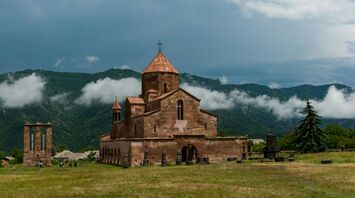Why Armenia Should Be on Your Radar in 2024

Head to Armenia this year and you'll find mythical mountains, ancient monasteries, and a rapidly developing farm-to-table food scene. Nestled in the heart of the Caucasus region, Armenia sits at the crossroads of Europe and Asia, offering a unique blend of history, hiking, and cuisine. Here’s a complete guide to visiting this unsung South Caucasus nation.
What’s Armenia Known For?
Armenia is renowned for its rich cultural heritage and breathtaking landscapes. The country, the first to declare Christianity as its official religion in 301 CE, is home to over 4,000 monasteries and churches. The Etchmiadzin Cathedral, one of the oldest Christian temples on Earth, stands as a testament to its deep-rooted faith.
For outdoor enthusiasts, Armenia's rugged mountains, old-growth forests, and semi-desert steppes provide a stunning backdrop. The Transcaucasian Trail, a 497-mile hiking route, is a must for nature lovers, blending agrotourism with culture. Additionally, Armenia boasts a viniculture tradition spanning over 6,100 years, with a burgeoning natural wine and brandy scene. The farm-to-table movement is thriving, focusing on wild herbs and fresh seasonal produce from rural villages.
Who Should Visit?
Armenia is ideal for those with a taste for adventure and culture. The landscape offers ample opportunities for activities like rock climbing in Noravank Canyon and kayaking at Azat Reservoir. Wine enthusiasts can explore the Vayots Dzor Wine Route, while history buffs will be captivated by Yerevan's museums and archaeological sites.
Design aficionados can trace the evolution of ecclesiastical architecture, and urban explorers will find Gyumri, the cultural capital, brimming with art galleries and workshops showcasing traditional crafts. Armenia's rich history and heritage, from pre-Christian sites to modern cultural hubs, make it a fascinating destination.
What Are Some of Armenia’s Main Draws?
Yerevan: Known as the 'pink city' for its rose- and coral-colored tuff stone buildings, Yerevan is filled with sidewalk cafes, tree-lined avenues, and open-air markets. Highlights include the Yerevan Vernissage, the Matenadaran manuscript museum, the Cascade Complex, and the History Museum of Armenia.
Monasteries: Within an hour's drive of Yerevan, several significant monasteries await. The UNESCO-listed Geghard Monastery, hidden in a gorge, Khor Virap with its view of Mount Ararat, and Zvartnots Cathedral, exemplify medieval architecture. The ninth-century Tatev Monastery, accessible via the Wings of Tatev cable car, is particularly spectacular.
Nature and Adventure: The verdant north of Armenia offers forest hikes from Dilijan to sapphire lakes and ancient ruins. Whitewater rafting on the Debed River can be paired with visits to the UNESCO-listed Haghpat and Sanahin monasteries. The south features Khndzoresk, a cave city, and Zorats Karer, a prehistoric site with over 200 carved monoliths.
Gastro Yards: Experience rural hospitality in Armenia's many 'gastro yards', where family homes and guesthouses offer traditional home-cooked meals. Sample national dishes like gata pastries near Haghartsin Monastery and local cheeses in Sisian.
When’s the Best Time to Visit?
Armenia is a year-round destination, each season offering unique experiences. Autumn is perfect for wine lovers, with harvest festivities in full swing. The hiking season extends into early November, showcasing the stunning autumn foliage. Winter is ideal for city breaks, soaking in Jermuk Hot Springs, and skiing in Tsaghkadzor or Yeghipatrush. Spring brings blooming apricot trees and pop-up dinners in orchards around Yerevan. Summer is best for high-altitude trekking, watersports on Lake Sevan, and witnessing sunsets in Debed Canyon.
With its rich cultural heritage, diverse landscapes, and burgeoning food scene, Armenia is a captivating destination ready to be discovered in 2024.



















